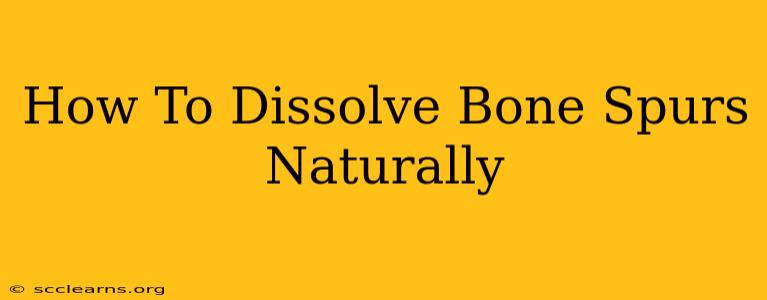Bone spurs, those extra bony growths that can cause so much pain and discomfort, are a common problem. While surgery is often suggested, many people are seeking natural ways to manage and even dissolve these pesky spurs. This article explores several natural approaches to help alleviate bone spur symptoms and potentially promote healing. Remember, it's crucial to consult your doctor before starting any new treatment plan, especially if you're experiencing significant pain.
Understanding Bone Spurs
Before diving into natural remedies, let's understand what bone spurs are. Medically known as osteophytes, bone spurs are bony projections that develop along the edges of bones. They often form in joints, such as the spine, hips, knees, and feet. Several factors contribute to bone spur development, including:
- Joint Injuries: Previous injuries or overuse can trigger bone spur formation.
- Arthritis: Conditions like osteoarthritis significantly increase the risk of developing bone spurs.
- Genetics: A family history of bone spurs can increase your susceptibility.
- Age: Bone spur formation becomes more common as we age.
Natural Ways to Address Bone Spurs
While you can't magically dissolve bone spurs overnight, several natural methods can help manage symptoms and potentially improve the situation over time.
1. Dietary Changes: Fueling Your Body for Healing
- Anti-Inflammatory Diet: Focus on foods rich in anti-inflammatory properties. This includes fruits, vegetables, whole grains, and fatty fish. Reducing inflammation is key to easing bone spur pain and promoting healing.
- Calcium and Vitamin D: These are crucial for bone health. Ensure you're getting enough through diet or supplementation (always consult your doctor before starting supplements).
- Reduce Sugar and Processed Foods: These can contribute to inflammation and hinder the body's natural healing processes.
2. Exercise and Movement: Keeping Your Joints Mobile
- Low-Impact Exercise: Activities like swimming, walking, and cycling can help improve joint flexibility and reduce stiffness, easing bone spur pain. Avoid high-impact exercises that could aggravate the condition.
- Stretching and Range of Motion Exercises: Gentle stretches can maintain flexibility and prevent further joint restrictions. Consult a physical therapist for personalized exercises.
- Yoga and Pilates: These practices emphasize gentle movements and strengthening core muscles, improving posture and reducing strain on joints.
3. Alternative Therapies: Exploring Holistic Approaches
- Acupuncture: Some studies suggest acupuncture may help alleviate pain associated with bone spurs.
- Massage Therapy: Targeted massage can help reduce muscle tension and improve circulation in the affected area, potentially easing pain.
- Chiropractic Care: Chiropractic adjustments may help improve joint alignment and reduce pressure on affected areas.
4. Home Remedies: Simple Steps for Pain Relief
- Heat and Ice: Applying heat or ice packs can provide temporary pain relief. Experiment to see which method works best for you.
- Epsom Salt Baths: Soaking in warm Epsom salt baths can help reduce inflammation and muscle soreness.
- Essential Oils: Some essential oils, like lavender and chamomile, possess anti-inflammatory properties and may offer soothing relief. Always dilute essential oils before topical application.
When to Seek Medical Attention
While natural remedies can be helpful, it's important to seek medical attention if:
- You experience severe pain.
- Your pain doesn't improve with home remedies.
- You experience numbness or weakness in the affected area.
- Your mobility is significantly impaired.
Conclusion: A Holistic Approach to Bone Spur Management
Dissolving bone spurs naturally requires a holistic approach that combines dietary changes, exercise, alternative therapies, and home remedies. Remember, consistency is key. By adopting these strategies and working closely with your doctor, you can effectively manage your bone spur symptoms and improve your overall quality of life. This information is for educational purposes only and should not be considered medical advice. Always consult with a healthcare professional before starting any new treatment plan.

